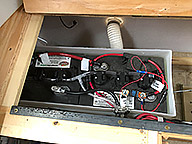

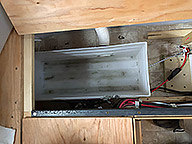

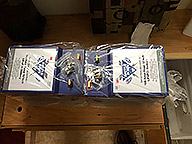
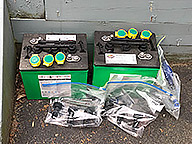
Changing from Lead Acid to Lithium Batteries in an Escape 21
Back to Jon Vermilye's Photo & Trip Page
Other
Trips:
Trailer Modifications - Escape 17B
Trailer Modifications - Escape 21
I probably should start out with why I am making the change. After all, most Escape 21 owners get along quite well with the factory supplied 220 amp hour 6V batteries. While I managed to do that for close to the first 2 years of owning the trailer, including two winters dry camping at Quartzsite, AZ in the desert, I wanted a bit more capacity. I found that after a string of cloudy days or camping in the shade, my batteries would be down enough that I couldn't use the microwave in the morning, and would need to switch to heating coffee water on the stove rather than using my 5 cup drip coffee maker. Could I work around this? Yes, as I noted, I did for two years.
My first thought was to add another pair of 6V 220 amp hour batteries. The problem - they would add another 130 pounds to the trailer weight, something that I really should avoid since I'm already very near the gross capacity of the trailer.
I have had a problem that some other owners of Escape 21's have had - the propane detector goes off when the batteries are charging from the solar panels. The solution to that would be to switch to AGM batteries, which generally do not produce hydrogen gas (which was what was setting off the propane detector). While that would offer a couple of advantages in addition to the propane detector problem, it wouldn't save any weight.
I talked with some of the people from Battleborn, one of the better known producers of lithium batteries at the Big Tent show in Quartzsite last January, and became convinced that it would be a worthwhile project. As someone that spent a lifetime on the cutting edge of sound system equipment & editing technology when teaching, why not do the same with my trailer!
Some general information about lithium batteries. They are considerably lighter than lead acid - the 12V, 100 amp hour lithium battery weighs 31 pounds. While rated at 100 amp hours, in most ways it is the equivalent of a 200 amp hour lead acid battery. A lead acid battery will have a much shorter life if discharged below 50% of capacity. A lithium battery can be discharged to 10% of capacity without damage. The voltage output curve of a lead acid battery is fairly steep, ie at 50% use it will be down to 12V without a load, and much lower if in use, which limits it use with an inverter since most shut down when the input voltage drops below 10.5V. A lithium stays above 12.8V all the way down to 20%, and the internal resistance is low enough that there is little voltage drop under load. The life expectancy of a lead acid battery is 5 - 7 years (although many have killed them in a year or two, and careful management can make them last well over 7 years). While lithium batteries for RVs have not been around all that long, the expected life expectancy is 3000 charge/discharge cycles, which works out to 8 years of doing a full charge/discharge cycle every day. Another advantage is charging. Lead Acid batteries require an absorption stage where the charging current is limited. Without limiting the charging current during the last 20% of capacity, the battery will produce hydrogen gas, and overheat. This results in long generator runs to top off the last 20% of battery capacity. While it is preferable to limit the charging current to 50% of the amp hour capacity, lithium batteries will accept 100% of their amp hour capacity charging current until full.
While that is a bunch of perks for the lithium battery , there are some problems. First, they cannot be charged if the battery temperature is below freezing or above 113°F. They should not be overcharged, ie when full, any charging voltage must be below 13.6 volts. While they can be charged at 100% of the amp hour capacity, the batteries will last longer if the charging current is limited to .5C, or 50 amps for a 100 amp hour battery. Most manufacturers of lithium batteries include a Battery Management System (BMS) built into the battery. I strongly suggest that you only consider batteries with built in BMS unless you have the ability to build one yourself. A BMS will limit charging voltages, not allow charging outside the acceptable temperature range, provide cell balancing, and limit the discharge rate.
One last concern - the LiFePO4 technology used in Battleborn & other lithium batteries designed for the RV industry is far less prone to self combustion compared to many other lithium technologies. These are not the batteries Boeing used in the Dreamliner!
Because a lithium battery has different charging characteristics than a lead acid, depending on your converter & solar controller, you may need to replace them. In my case the 55 amp WFCO converter would meet the voltage requirements of the lithium batteries in theory, but WFCO converters are famous for never going into the bulk mode, which would mean it would be very slow (if at all) to fill the battery to capacity. I have an additional problem - I carry a 700/900 watt propane only Ryobi generator that I use the few times my solar system doesn't fill the batteries. The lithium batteries have very low internal resistance, and will charge at the full output of the converter. At 55 amps output, the WFCO (and any other 55 amp converter) will draw more than 700 watts at 120V, causing the generator to shut down. I will be switching to a lithium 35 amp converter (a Progressive Dynamics PD 4635LIV) replacement for the converter section of the WFCO. The GoPower solar controller does not have a lithium charging option, so I will be switching to a Victron SmartSolar 100/30 MPPT solar controller.
The last problem is the cost. No matter how you look at it, lithium batteries are a premium product. The current price for the 100 amp hour battery from Battleborn is $949.00 for the standard 12V format & $1049.00 each for the GC2 version (a 12V, 100 amp hour battery the same size as a 6V deep cycle battery). While there are less expensive brands, and you could buy the individual cells from China and assemble a battery yourself, you would still need to design a BMS to protect the cells.
For more information about LiFePO4 lithium batteries, check this Solacity page.
So, some photos of the start of the process:
 |
 |
 |
 |
| The Old | Old Shunt | Empty Battery Box | Battleborn Battery |
 |
 |
||
| The Pair of New Batteries | Make Me an Offer! |
The 68 pound Interstate batteries were a bear to get out of the battery box. I used some strapping through the slots on the top of the battery to lift them, but they sure are heavy. I had added a watering system since the passenger side battery was tough to get at to fill, and pulling that was "interesting" while trying to avoid spilling battery acid when removing the plumbing. I also have a set of Water Miser caps that I tried & didn't like (too difficult to check electrolyte levels) so the batteries, watering system & caps are up for grabs. I'm not willing to ship them, but anyone that wants some 2 year old 6V Interstate batteries & the accessories and is willing to come to Oswego is welcome to them.
I tried the batteries in the Escape battery box, and they are large enough that there is no room for cables. The old batteries had a 3/4" space between the battery top & the cover. The Battleborn batteries completely fill the box. I decided to cut down the battery box. The cover will still fit resting on the battery tops, and there will be a 1 1/2" space between the top & the battery boxes through which I can run the cables.
Speaking of cables, I measured the new cable runs, and will order the cables tomorrow. All will be #0 stranded wire from Genuine DealZ. I'm sure I could get them for less, but I've been happy with their workmanship. By the way, I have complained in the past about Escape undersizing their inverter cables. When I pulled the old cables, I discovered that they are #2 wire, just one wire size down from that recommended by Xantrex for their 1500 watt inverter. I apologize!
I discovered that there are slots or tabs for webbing to lift the Battleborn batteries, so I added some old webbing I had lying around to make it easier to put them in & out.
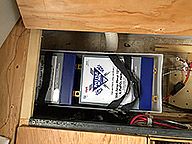 |
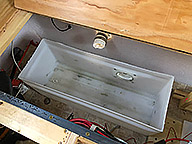 |
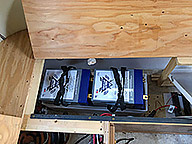 |
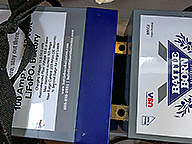 |
| Batteries in the Box | The Cut Down Box | Batteries in Cut Down Box | Spacing Problem |
 |
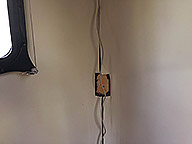 |
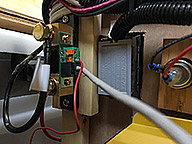 |
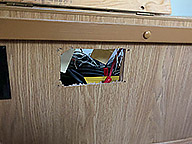 |
| Space for Cables | Running the Shunt to Monitor Cable | The New Shunt | The Hole After Removing the GoPower Solar Controller |
Another problem the existing battery box has is the two batteries are jammed together (they just fit). That leaves the terminals of the left battery digging into the case of the right battery. Road vibration would probably wear a hole in the plastic case. There is just enough space for me to add a couple of shims to keep them from touching.
I pulled the corner cover of the trailer to remove the old wiring between the shunt & Bogart monitor, and ran the new cable for the Victron monitor. While both shunts are 500 amp devices, the Victron shunt has a different cable, and there appears to be some electronics as part of the shunt. I also pulled the GoPower solar controller. I tried to find a piece of anodized aluminum to cover the hole, however the ebay supplier never got back to me. I will probably purchase a piece of 16 gauge aluminum & paint it. The Victron monitor will fit in the box that held the Bogart TM 2030A but will need a 2 gang cover plate with a 2" hole. While my local hardware store didn't have one in stock, it is on the way. I only changed to the Victron BMV-712 battery monitor because I wanted the additional, and easier to obtain battery data that the Bluetooth linked Victron devices provide.
The GoPower solar controller does not have a setting for lithium batteries, so I decided to go with a Victron MPPT controller. The SmartSolar 100/30 also provides Bluetooth monitoring and configuration.
As I noted above, the original WFCO WF8855 converter has specifications that would work for lithium batteries, but there is a big but. The WFCO converters are famous for never going into the boost mode. Since that is the only mode of the WFCO converter that meets the 14.4V - 14.6V charging voltage for the Battleborn batteries, I decided to change to a lithium rated charger from Progressive Dynamics. A second problem has been created by my desire to not carry a gasoline fueled generator. The reality is I haven't wanted to carry a generator at all, and for the first 9 years of trailer camping I haven't. I guess I'm getting soft in my old age. I don't want to shift into the energy conservation mode after a string of cloudy days.
I found a Ryobi 900/700 watt propane only generator. Very small & light. It can operate from 1 pound disposable cans, & has an adapter to attach it to a larger tank. I've already used it and it is fairly easy to start, and, with the WFCO converter, did recharge (slowly) my 6V lead acid batteries. As noted above, the problem is lithium batteries with the properly designed converter draw the full output of the converter until full. While this is an advantage for most since it means fast recharging, it is a problem with a small generator. The exact replacement for my WFCO converter is the PD4655LIV (55-AMPS). The problem is it draws 950 watts, more than the generator will produce. The smaller 35 amp version, the PD4635LIV (35-AMPS) draws 550 watts. Progressive Dynamics says their converters are power factor corrected. If so, there should be no problem running it from the generator.
So, first removing the WFCO bottom section. An easy task -two screws removes the front cover, and two more to detach the converter/charger section of the power station. The advantage of using a replacement is you do not need to rewire the 120V or 12V section of the WFCO power station.
Three wires (hot, neutral & ground on the 120V side) & two (+ & - on the 12V side) and the unit can be removed. The first "interesting" problem comes from not reading the instructions. I slid the PD converter into the space left by removing the WFCO converter section and it wouldn't fit. After a call to Randy at Best Converters, I was informed that you need to remove the power supply from the metal enclosure it is shipped in (Line 8 in the instructions). So, I read the instructions. No problems after that. I haven't powered it up since I don't have the new battery & inverter cables. I did order them today. six custom length #1/0 color coded cables with terminals & heat shrink for $68.26. Yes, I could have done it cheaper, but I like GenuineDealZ's work, and I don't have a crimper for #1/0 terminals
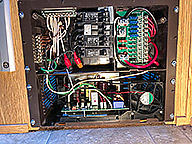 |
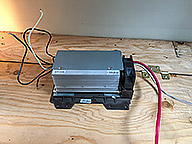 |
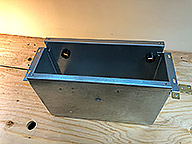 |
| The New Converter Bottom | The WFCO Converter | The Metal Case |
The rest of today's trailer time is another project - a direct wire from the battery to the radio. Like all modern automobile radios, when disconnected from the 12V supply, all programing goes "poof". While station programing doesn't mean all that much to me since I am continuously moving from station to station, the various menu settings, particularly shutting off the "Demo" mode does. So, I'm running a fused 12V run that bypasses the 12V trailer disconnect. It also has the advantage that the radio is currently wired to the same circuit as the LEDs on that side of the trailer and the cell phone amplifier. With either on, the FM reception is diminished by line noise. I hope the new wiring will solve the problem. Fishing the wires behind the refrigerator, cabinets & furnace is quite a project. I didn't finish, but using some Harbor Freight fiberglass wire running sticks got me all the way from the converter to the furnace. Tomorrow is another day!
The conversion to lithium batteries is just about done. I need to clean up some wire runs, and connect the new direct wire from the battery to the radio, but the system is up & running.
The first photo is a pipe cap on the old battery box vent. I don't need it for the lithium batteries (it never worked all that well with the lead acid) and since I moved the battery box towards the center of the trailer to make it easier to insert & remove the batteries, I added a removable plug. I added a 40 amp marine circuit breaker to shut off the solar panels if necessary. After many false alarms from charging batteries, I added a switch for the propane detector. I hope I won't need it anymore!
While not directly related to the lithium batteries, I added a DC to DC converter in the run from the tow vehicle to the battery. Without increasing the voltage coming from the tow vehicle, it would not provide much charging for the new batteries. I set the output for 14.4V.
The photo of the status of the solar controller & the battery monitor don't really show much - the batteries are full and it is pouring rain.
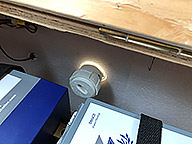 |
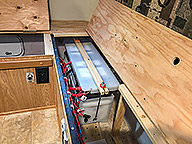 |
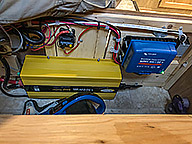 |
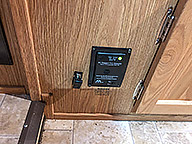 |
| The Plugged Vent | The Batteries & Box | Inverter, Solar Panel Breaker & Solar Controller | Propane Detector |
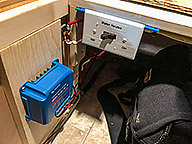 |
 |
 |
 |
| Victron DC to DC Converter | Victron Solar Controller | Victron Battery Monitor | Battery Monitor |
While not a terribly difficult project, I find working on my hands & knees is far less fun that it used to be. At 74, I don't bend as well as I did in the past.
A PDF of the project cost. Was it cost effective? Probably not, but I like to try new things, and I do hope it will let me pay less attention to the battery conditions when dry camping. I also used it as an excuse to change over to the Victron solar controller & battery monitor because they let me check them (as well as change the settings) using my phone.
That is pretty much it. I'll add a report of how well the conversion works after the next camping trip.
I had to try the microwave:
I'm pretty impressed with the result. I shut off both the AC & solar feeds to the batteries then fired up the microwave on the inverter, drawing 154 amps. The battery voltage dropped to 12.8 during the run.
After the microwave shut down (and after consuming 6 amp hours) the battery voltage was back up to 13.5V. I plugged the trailer into AC and the new Progressive Dynamics 35 amp converter kicked in, supplying full current (34.7 amps) until the battery reached around 14.2 volts when the charging current tapered off as the batteries climbed to 14.45V, the normal resting voltage with either the converter or solar controller on, and current dropped to what the trailer was consuming (without the microwave - .3 amps). The "full" voltage of lithium batteries covers a wider range than lead acid batteries. 13.6 to 14.4 is considered full.
I turned the solar panels back on & the solar controller is in float with an output of 0 amps.
I discovered something that I should have realized when I added the DC to DC converter to the trailer charge line. The power tongue jack gets its 12V from the charge line. Adding the converter kills power to it unless the truck is connected. It also kills power to the break away switch. Today's project was to run a #8 wire from the battery disconnect switch to the front of the trailer, and splice in both loads. A very difficult wire run in an Escape 21. Lots of individual walls & support 1' X 2"s to snake through. It is near finished - the run is done, but the splices in the front end are still waiting until the rain stops.
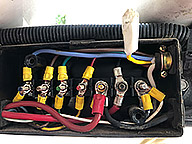 |
| 7 Pin Junction Box |
I finished up the run from the battery disconnect switch to the tongue jack & breakaway switch. The only thing left to do is put a cover over the hole where the old GoPower converter was located. The metal plate is on order.
An update on the batteries in the field:
I just returned from 4 days at a couple of NY campgrounds without hookups, using 2 100 amp hour Battleborn batteries, combined with a Victron SmartSolar 30/100 controller. While a bit of sun at the start of the first day, mostly rain, and clouds the second day. I arrived at the campground with the batteries at 88%. Used 35 amp hours the first day, 32 amp hours the second, and rarely saw positive amps going into the batteries. Moved to a different campground & between the solar panels & truck charge line, put it all back in on a 105 mile drive; parked in heavy shade. Used 45 amp hours the day before & 65 amp hours yesterday. Put all of it back on the 233 mile trip home.
Rather than my usual attempt at using minimal electricity over the last two days of the trip, I did everything as if I had hookups (except the air conditioner). By morning today, I was at 65%, and, as mentioned before, was back to full in 4 hours.
While I certainly don't believe that lithium batteries are for everyone, I sure appreciate them!
5/5/20 Update:
Now that I have a full winter using the lithium batteries "under my belt", I am adding an update. I spent the winter dry camping in Quartzsite, AZ. A total of 71 days between hookups.
While during December I did not deplete the batteries to the point where I had to run a generator, after a 3 day stretch without enough sun to put the controller into the float mode, and being down 54 amp hours, I ran a small propane generator for 4 hours to bring the batteries back to full (and do a monthly generator run). This was probably not necessary, although the prediction was for another 3 days of heavy clouds. The lithium batteries can be safely drawn down to 10%, so I could have gone without the generator, but I needed to run it anyway, and I tend to be a bit conservative.
This has been the coolest & most cloud covered winter I've stayed at the Q over the last 4 years so the results would probably be better under more usual conditions. This is for December 9 - December 31. (21 days). Today (the 31st) is obviously not finished, but as of 11:00 AM I'm putting 91 watts into the trailer, had a peak of 195 watts, and collected a total of 250 watt hours (it is cloudy). Still down 49 amp hours for the day (I did not reach float yesterday).
Peak solar wattage - 423 watts. Minimum solar wattage - 42 watts. Peak KW hours collected - 1.49KWh. Lowest watt hours collected - 140 watt hours. # of days the controller never received enough sun to get out of the bulk mode - 7.
# of days the batteries reached full - 15. Largest discharge - -72 amp hours.
The image below is the December solar output. White = Bulk, Gray = Absorption & Light Blue = Float. December 1st - 9th were spent at a campground with hookups.
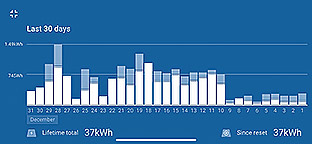 |
| December Solar Panel Output |
The conclusion after a winter using lithium batteries is they are one of the most useful upgrades I've done to the trailer. I no longer have to consider the battery State Of Charge when deciding to use them. Unless I need the air conditioner, I have no reason to carry a generator.
Spring, 2021 -
While I had no problem making it through 3 cloudy days with 2 Battleborn batteries (I was down to 74%) I decided to add one more 100 amp hour battery. A couple of reasons - First, Battleborn does not recommending adding an additional battery after 2 years, so it is now or never. Second, I really wanted to be able to go a week without sun. Third, there was just enough empty space under the rear bench seat for 3 of the GC2 format batteries.
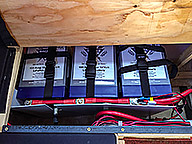 |
| 3 GC2 Size Battleborn 12V Lithium Batteries |
Since installing the 3rd battery I have only done one night of dry camping, so I haven't had a chance to see how long I can go, but after running the microwave, toaster & coffee maker, I was down to 95% so things look good.
This page is maintained by: vermilye@oswego.edu
Last Update:
May 21, 2021